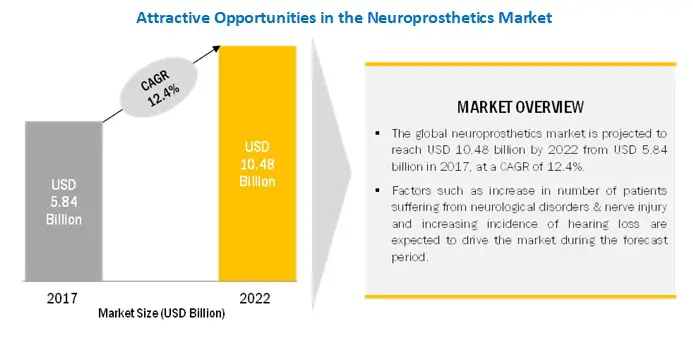The neuroprosthetics market is expected to reach USD 10.48 Billion by 2022 from USD 5.84 Billion in 2017, at a CAGR of 12.4% from 2017 to 2022. Increasing number of neurological disorders, increasing incidence of hearing loss, increasing prevalence of diabetes, and increasing cases of amputation due to the rising number of accidents & injuries are major factors that are driving the growth of this market.
Get a PDF Sample Report: https://www.marketsandmarkets.com/requestsampleNew.asp?id=234147399
North America is expected to command the largest share of the market during the forecast period.Based on region, the neuroprosthetics market is segmented into North America, Europe, Asia Pacific, and the Rest of the World (RoW). In 2017, North America is expected to command the largest share of the neuroprosthetics market. The large share of this market can primarily be attributed to the high incidence of vision and hearing loss, rising prevalence of neurological disorders, and the strong presence of industry players in this region.
Opportunities: Expanded target applications and new indications
Neuroprosthetic procedures involve minimally invasive techniques as opposed to alternate surgical procedures for treating tremors primarily associated with Parkinson’s, which are invasive treatments. For instance, in a pallidotomy, the surgeon destroys a tiny part of the globus pallidus by creating a scar to reduce brain activity. Doctors do not prefer this procedure and encourage the use of deep brain stimulation; instead, as it does not destroy brain tissue and has fewer risks as compared to pallidotomy. The use of DBS in newer applications/indications, such as Alzheimer’s, epilepsy, and depression, is currently in clinical trials. Similarly, the treatment of heart failure, sleep apnea, obesity, and tinnitus through VNS (Vagus Nerve Stimulation); fecal incontinence by SNS (Sacral Nerve Stimulation); and tinnitus, migraine, and stroke by TMS (Transcranial Magnetic Stimulation) are also under clinical trials. TMS is currently used to treat depression, SNS for urine incontinence, and VNS for epilepsy.
Some of the major players operating in the neuroprosthetics market are Boston Scientific (US), LivaNova (UK), Medtronic (US), Abbott (US), Cochlear (Australia), and Second sight (US).







